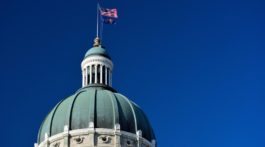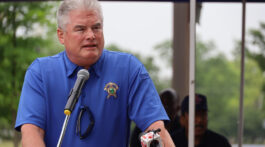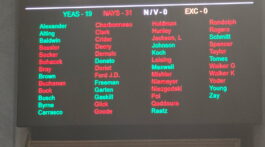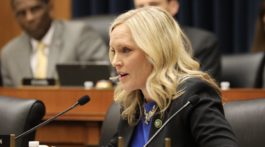by Chris Watts
Indiana entered a new chapter in our response to COVID this week: The statewide mask mandate became an advisory on Tuesday. Limits on vaccine eligibility have been lifted, and more than one in five Hoosiers are now fully-vaccinated against the virus.
In Indianapolis, the return of the NCAA basketball delivered a much-needed boost to the local economy – but an outbreak at one of the city’s most iconic restaurants is a somber reminder that the pandemic is still with us. The state’s positivity rate has ticked upward over the last two weeks, and Marion County is among the counties continuing a mask mandate as a post-tournament protection.
There’s light at the end of the tunnel…but it signals “proceed with caution,” not “full speed ahead.”
There’s been heated debate in the General Assembly over the Governor’s emergency powers, the limits of local health authorities, even preempting the health emergency altogether. The impact of “shutdowns” on the state’s economy is often cited, but there’s a tendency to look at restrictions without considering the alternative – COVID spreading unchecked to claim the lives and diminish the productive potential of many more Hoosiers.
Recognizing the pressure to ease precautions, there’s a compelling economic and fiscal case for continued caution – let’s not snatch defeat from the jaws of victory against COVID, and risk a setback that slows our recovery (and revenues).
Since its peak last April, Indiana’s unemployment rate has steadily declined, even while re-opening paused during the summer and for the duration of the mask mandate. The impact on tax collections has also been more modest than expected. A recent state-by-state analysis from Pew shows Indiana squarely at the 50-state median of revenue projections for 2020 and 2021 (stalled around 2019 levels).
As lawmakers negotiate the 2022-23 state budget, they’re guided by a revenue forecast that assumes approximately $1.75 billion in growth over the current COVID-ravaged biennium. These projections rely on payroll employment recovering to pre-pandemic levels in early-to-mid 2022.
We’re on pace to hit this prediction. Will ending restrictions too abruptly add more hurdles to the path back to normalcy?
A national analysis of 2.5 million businesses by University of Chicago researchers show similar declines in consumer activity regardless of state or local shutdown orders – fear of infection drove behavior more than government mandates. A recent Harris/USA Today poll shows cautious attitudes persisting, as more than one in five adults said they’d wait to resume their normal routines until the nation hits herd immunity. A new surge in cases could undercut the confidence built by the vaccination efforts.
An interpretation of local tax collections suggests many Hoosiers share these sentiments.
IFPI recently released an analysis of local food and beverage (FAB) taxes, which are reported monthly and track the curve of the pandemic fairly closely. Across the 28 cities and counties that collected FAB for the last two years, 2020 revenues finished $15.3 million (-15%) below 2019. That decline isn’t surprising, but data from last fall deserves a closer look.
COVID crushed FAB revenues in April and May, as expected. The summer months saw losses narrow a bit as more residents ventured out to restaurants and bars and took advantage of outdoor dining.
Then came September. The return of fall also saw a strong rebound in FAB revenues across nearly all jurisdictions – all except Marion County actually beat 2019. We enjoyed warmer and drier weather than the average Indiana September, and a continuation of ‘Back on Track’ Stage 4.5. This seems to have fostered a sense of complacency, combined with ‘COVID fatigue’ – but it was short-lived.
October brought a sharp reversal of September’s FAB gains, as collections lagged October 2019 by more than 20%. But Governor Holcomb moved the state to Stage 5 re-opening on September 26th, and Marion County eased restrictions thereafter: If customer behavior was dictated only by public health orders, FAB revenues should have continued on an upward trajectory.
But COVID daily case counts had also risen sharply in October, presumably in response to our relaxed vigilance. October FAB data suggests customers recognizing the renewed threat and adjusting their behavior even before the state’s retreat from Stage 5 in November and tighter local capacity based on county-by-county data.
Without overanalyzing a few months of tax information, it appears that Hoosiers acted ahead of health officials to keep their families safe, even though they inevitably bridle at prolonged restrictions.
A cautious approach to COVID is consistent with a steady and sustainable recovery: The virus (not the government response to it) is the essential challenge to consumer confidence and commerce that must be ended to resolve the crisis. State and local policymakers should keep this in mind as they work to strengthen Indiana’s economy and stabilize our tax base beyond the pandemic.
Chris Watts is the Director of the Indiana Fiscal Policy Institute.














